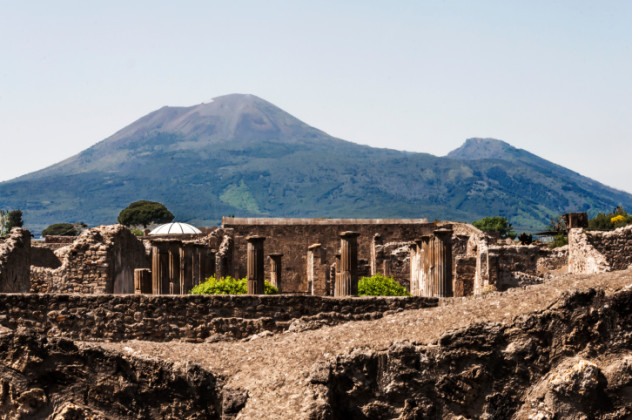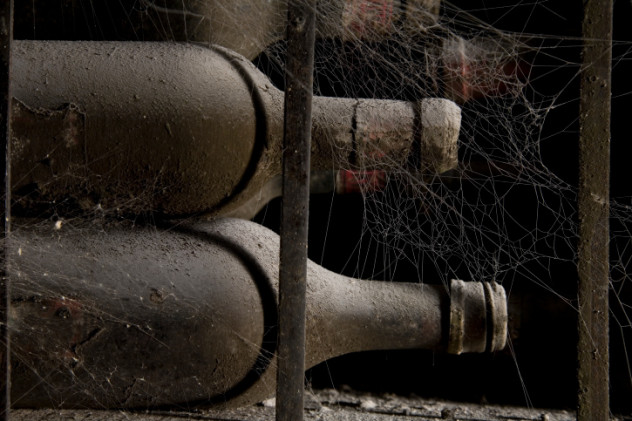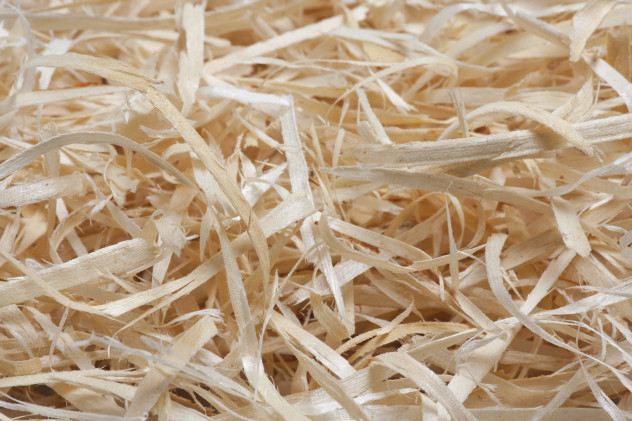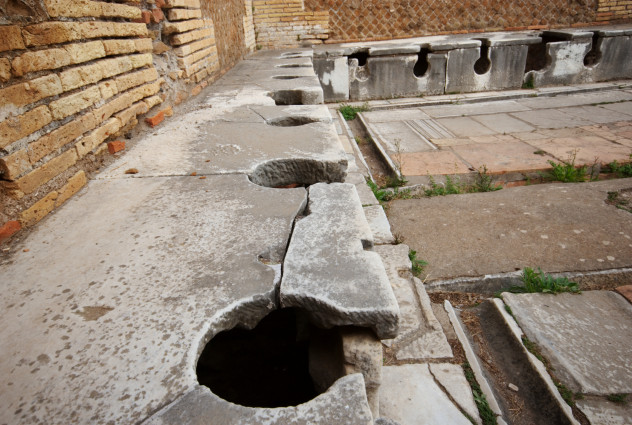 History
History  History
History  Movies and TV
Movies and TV 10 Fictional Kings Who Go from Good to Bad
 Food
Food The Fantastic Chemistry Behind Why 10 Popular Foods Taste So Good
 Technology
Technology 10 Futuristic Fungal Technologies
 History
History 10 Not-so-Spooky Events That Also Happened on October 31
 Creepy
Creepy 10 Unsettling Ghost Stories to Tell This Halloween
 Crime
Crime 10 Truly Evil People Who Used Halloween as the Perfect Cover
 Movies and TV
Movies and TV 10 Wildly Different Movie Takes on Nuclear War
 Creepy
Creepy 10 Places Where Folklore Is Alive and Well
 History
History 10 Events That Unexpectedly Changed American Life
 History
History 10 Weird Distractions from the Great Depression
 Movies and TV
Movies and TV 10 Fictional Kings Who Go from Good to Bad
 Food
Food The Fantastic Chemistry Behind Why 10 Popular Foods Taste So Good
Who's Behind Listverse?

Jamie Frater
Head Editor
Jamie founded Listverse due to an insatiable desire to share fascinating, obscure, and bizarre facts. He has been a guest speaker on numerous national radio and television stations and is a five time published author.
More About Us Technology
Technology 10 Futuristic Fungal Technologies
 History
History 10 Not-so-Spooky Events That Also Happened on October 31
 Creepy
Creepy 10 Unsettling Ghost Stories to Tell This Halloween
 Crime
Crime 10 Truly Evil People Who Used Halloween as the Perfect Cover
 Movies and TV
Movies and TV 10 Wildly Different Movie Takes on Nuclear War
 Creepy
Creepy 10 Places Where Folklore Is Alive and Well
 History
History 10 Events That Unexpectedly Changed American Life
10 Reasons The Past Was Way More Disgusting Than You Realized
So, you’ve finally done it. You’ve finished converting your old Delorean/British police box into a functioning time machine and are ready to blast off on an adventure. Where first? Ancient Rome? Greece? Renaissance Florence?
We hate to break it to you, but the best option would probably be “none of the above.” For all we like to romanticize the past, the truth is that most of our shared history was less “awe-inspiring” and more “vomit-inducing.”
10Pompeii Was One Giant Garbage Dump

Before it got buried under a cloud of ash, Pompeii was the ancient equivalent of the French Riviera. It was a place where rich Romans came to unwind after some hard empire-building. But there was one crucial difference between ancient Pompeii and a modern resort town: Pompeii was absolutely overflowing with garbage.
Instead of having a waste collection program, or even rudimentary landfills, the people of Pompeii just dropped their trash wherever they felt like it. Streets, alleys, and even cemeteries were filled with broken pottery, building remains, uneaten food, and horse carcasses. Get off the street and things were no different. There’s plenty of evidence that locals treated their houses like one giant trash can, with the fossilized remains of rotting food found littering floors and piled up alongside drinking water.
According to Allison Emmerson of the University of Cincinnati, trash was regarded as just a fact of life in Pompeii. Even the tombs of ancestors were considered an acceptable place to dispose of waste. That undoubtedly made the city stink to high heaven in the summer months.
9The Vikings Were Plagued With Parasites

It’s no surprise that Viking life was hard. With Vikings spending a lot of time on ships sailing rough northern seas during one campaign of conquest or another, no one would picture their lives as anything other than difficult. Even the most cynical person would likely miss one key detail, though: Viking guts were utterly infested with parasites.
Thanks to a culture which promoted close living with livestock, most Vikings were exposed to a whole load of nasties from a very early age. By the time they reached adulthood, their insides were crawling with the sort of creatures H.P. Lovecraft had nightmares about. Researchers who studied Viking poop have found eggs indicating chronic roundworm and liver fluke infections.
Worst of all, there was evidence of whipworm. Found in piles of Viking feces dating back to 1018, whipworm would have made the Viking’s lives unbearable. Aside from severe diarrhea and acrid-smelling farts, those infected could’ve expected painful passage of stool, growth retardation, and impaired cognitive development.
8Medieval London Stank To High Heaven

Let’s say you decide to skip the obvious places and take your time machine on a trip to medieval London. You’d probably be prepared for the city to be dirtier and smellier than it is now. But you might not be prepared for exactly how big a difference it would be. To be blunt, London in the Middle Ages stank to high heaven. The streets were filled to overflowing with excrement, and people routinely dumped rotting food and animal entrails out in the open to fester. In some places, this foul mixture was so deep the streets were effectively impassable.
Things were no better by the river. Butchers threw rotting meat into the Thames, and blood was left to congeal on the banks in the sun. By the 14th century, the stench was so great the king was forced to ban the slaughtering of animals inside the city. To top it all off, tanneries were working around the clock to boil leather, producing a stench that suffocated the entire city.
7Renaissance Europe Was Crawling With Syphilis

The words “Renaissance Florence” evoke images of absurdly dressed men wandering around pristine cities, solving great mysteries, and inventing the scientific method. What they don’t evoke are images of syphilitic beggars writhing in agony in the streets, their faces falling apart before onlookers’ eyes. Yet, that’s exactly what Michelangelo or Da Vinci could expect to see strolling through town.
In 1495, a group of French soldiers returning from the New World had brought with them an unexpected treat. Known today as syphilis, the disease was the Renaissance equivalent of the AIDS pandemic but even scarier. The symptoms were terrifying. Weeping pustules would explode across people’s faces, hair would fall out and—in the worst cases—the flesh would be eaten away right down to the bone. And since there were no hospitals or care homes to speak of, those that caught the dreaded “French disease” were left to suffer out in the open.
As a result, Renaissance society was caught in a state of permanent panic about the grotesque effects of fornication. Contemporary accounts are filled with a paralyzing dread at the thought of becoming infected, and woodcuts display horrific examples of the disease. The whole of Europe was either afraid, infected, or both.
6Ancient Greek Wine Was Really Disgusting

Wine was a big deal in ancient Greece. People wrote poems to the stuff, they had their own god of wine, and Homer even used it as a metaphor to describe everything from animals to the ocean. So, the first thing you’d do in ancient Athens is sample this wonderful drink, right? Only if you wanted to completely destroy your taste buds. Ancient wine was disgusting.
The trouble was no one had yet figured out how to preserve wine for long periods, and ancient vintners tried all sorts of bizarre tricks. It wasn’t unusual to find resin or marble dust added to wine at the vineyard, with salt and lead being two other favorites. Some simply gave up fighting nature, and they left their wines outside to oxidize until they were bursting with bacteria. As a result, wine was usually either a thick, tar-like substance we would consider undrinkable or a glass of bug-infested vinegar.
Bad as all this is, it got even worse when it came time to drink the wine. Ancient Greeks would frequently cut their wine with seawater to make it more “palatable.”
5Personal Hygiene In The 18th Century Was Abysmal

Imagine living in a society where people routinely fart in public, blow their noses into their hands, spit indoors, and relieve themselves in front of company. Sound like something from an OCD nightmare? It’s exactly what you’d experience if you took your first time-traveling vacation in 18th-century England.
For most people, hygiene was nothing more than a fancy word they couldn’t spell. The average man on the street had breath that could strip paint, and social niceties were unheard of. It was far from uncommon to eat a meal with your hands, wipe those hands down your shirt, and then fart loudly before spitting a wodge of mucus onto the floor.
But what if you limited your journey to the homes of the upper classes? Sorry, but they were no better. While conversing after dinner, men would often pull out a chamber pot and relieve themselves in front of guests.
Even if you spent your entire vacation avoiding other humans at all costs, you’d still encounter their disgusting by-products. Human waste was so prevalent that any food, water, or milk you could get hold of was probably contaminated in the grossest way possible.
4Ancient Mesopotamia Was Crawling With Pests

Like Pompeii and medieval London, ancient Mesopotamia had little in the way of waste disposal and sanitation. The inevitable result was pests on an enormous scale. Unlike in London or Pompeii, we know that feral animals were actually encouraged by the Mesopotamians. It turned out they had a part to play in society: garbage disposal.
To deal with piles of refuse, cities across Mesopotamia allowed feral dogs and scavenging pigs to run the streets. We don’t just mean in the outlying and poor districts. Teeth and bones collected by archaeological expeditions show these animals got absolutely everywhere. Under the Hittites, feral pigs were even encouraged inside the palace of the king.
More disgustingly, the widespread nature of garbage also meant every centimeter of your typical Babylonian city was crawling with big fat rats, fleas, and other disease-carrying pests. As a result, infection by plague and a horrible, messy death was an ever-present worry, and this worry was compounded by the presence of nasty, food-borne parasites like trichinellosis.
3Georgians Stuffed Their Mouths With Dead People’s Teeth

In 1815, two of the greatest armies on Earth met for the apocalyptic Battle of Waterloo, a bruising engagement that killed roughly 50,000 men. Aside from stopping Napoleon in his tracks and shaping European history, the battle had a strangely gross effect on one school of medicine: dentistry.
Prior to Waterloo, rotten teeth were one of the most feared ailments in British society. With no such thing as fillings or regular check-ups, bad teeth ruined many people’s lives. But when the battle was over, Europe suddenly found itself in possession of thousands of young corpses—each with a mouth stuffed full of healthy teeth.
What followed was one of the grossest booms in product history. Pieced together from dead men’s jaws, dentures suddenly became widely available on the market. The Georgians went nuts for them. For decades, people willingly wore the smiles of men killed on the battlefield in place of their own. It wasn’t until Claudius Ash began manufacturing porcelain teeth in the 1830s that this gruesome trend finally fell out of fashion.
2Toilet Paper Used To Be Horrifying

As people who probably grew up with indoor flushing toilets and paper marketed as “quilted” or “extra comfort,” it can be hard to appreciate how difficult our ancestors had it. Go back less than 100 years and using the bathroom used to be downright unpleasant. One of the most general methods for wiping yourself was to use an old newspaper or catalog. The old Farmer’s Almanac even came with a hole so it could be hung up in outhouses. Not that we can blame our grandparents for avoiding toilet paper. Until the 1930s, it was totally possible to buy paper that was full of splinters.
In 1935, Northern Tissue (now Quilted Northern) made a killing advertising its toilet paper with the tagline “Splinter-Free!” The sheer success of the product shows us that even by the time FDR was in the White House, plenty of people were legitimately worried that wiping with the wrong paper would leave them sporting splinters in a very tender place. It’s only in the last 80-odd years that companies have finally overcome this painful obstacle.
1Roman Toilets Were Terrifying

If you’re one of the many people who has a thing about peeing in front of others, be glad you didn’t live in ancient Rome. Back then, the words “public restroom” were taken very literally. Up to 50 people would sit in a circle doing their business in plain view of one another and, when they were finished, wipe themselves on a communal sponge as dirty and disease-ridden as, well, a shared butt-wiper. Sound like the worst toilet experience you can imagine? We’re only just getting started.
Although Roman sewers were advanced for the time, they were woefully inadequate by our standards. With no U-bend to speak of, toilets opened directly into dark drainage channels through which insects and what Discover Magazine calls “biting creatures” frequently emerged. Thanks to the buildup of methane, it was also totally possible for jets of naked flame to suddenly explode out the holes. This made the simple act of going to the toilet like playing the worst version of Russian roulette imaginable.
Unsurprisingly, all this nastiness made the average Roman very wary of the toilet. Archaeological excavations have uncovered magic spells scrawled on bathroom walls to ward off demons and images of the goddess Fortuna designed to bring good luck. When your trip to the restroom could result in your ass getting bitten or badly burned, you probably need all the luck you could get.








